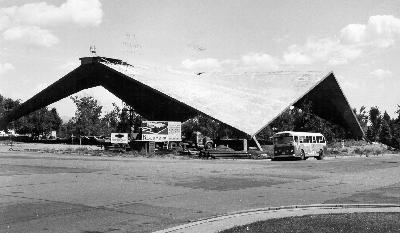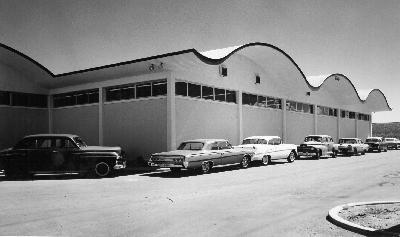|
This is a shell:

It is called a hyperbolic paraboloid, from a mathematical equation of the same name. My mother wanted to call it an iambic pentameter. Most now use the name hypar instead. This one is at the Broadmoor Hotel in Colorado Springs. It is 185 feet square, (260 feet across the diagonal) and about 50 feet high. The thickness of most of the structure is a mere 3 inches except for the thick edge members around the edges and across the top.. This is only one of many types of shells. You could invent a new type every day for your lifetime and still not invent them all. Some of the common types are hypars, translations shells, domes, barrel shells, and, folded plates. If you want to see a presentation of types go to Mark Ketchum’s home page, to the section called Types and Forms. Back to the hypar: Why are we able to span 260 feet and be only 3 inches thick? The reason is double curvature. Note that from the middle of the side of the roof, to the other middle point,, this shell sags, and from the center point to the lower corner, the shell humps. The sag is called a catenary, and the hump is called an arch. A catenary carries load in tension, and an arch carries loads in compression. We have the structure carrying loads in two ways. Think about this awhile. The other factor is the edge members. They carry the loads from the edges of the shell to the ground. In this case they are much thicker and are well reinforced. For the Broadmoor shell they are prestressed with steel cables. Most shells have this property of carrying load in several ways. That is except for barrel shells and folded plates. For example, a barrel shell carries load as a beam from support to support and crosswise as an arch. If we want to get technical, the barrel shell is not a true shell. This is the end of the tutorial but I hope you do not stop here. Look at pictures of shells, and try to figure how the forces work. Make models. You will learn how they are built and how they perform. Only then should you turn to the structural theory. Just for start. Here is a picture of a barrel shell.

For further information see this link to a short list of types and forms
|